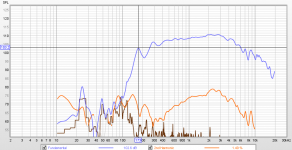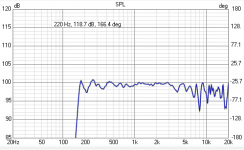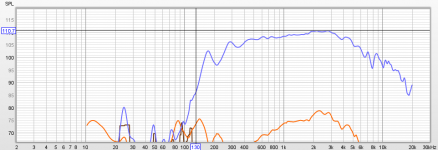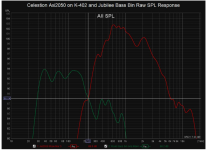The idea was to be as close as possible to the diagram to pick up on any distortion hinting at xmax. The closer the the 2 points, the more accurate the information. I think because of the situation, pulling the mic away will allow enough intimacy and lower peak.Whether reading peak or RMS, a compression driver driven near full power can reach in the 160dBSPL range at the throat, but there is no reason to measure at the throat, or "several inches" from the throat- measuring inside a horn is not representative of what you (or your mic) will hear at a listening position.
These measurements of THD
Are not correct. Raising the slope steepness of a XO point shouldn't make THD go up. I must assume that the noise floor or ambient noise is too high to get an accurate reading, no one has suggested anything on the topic.
Ok I think I got the bottom of it. I have Rew set to measure 10-80hz.... the sweep goes well past 80hz, to ~155hz......it is hear that headroom is gone, and it should be.... but why is Rew wanting to sweep past the measurement criteria???
Last edited:
Yeah, we should put vocal mics in the throat, rather than in front of the singer's mouth 🙄The idea was to be as close as possible to the diagram to pick up on any distortion hinting at xmax. The closer the the 2 points, the more accurate the information.
Horn measurements are less accurate in the near field.
A working “rule-of-thumb” for determining the boundary between near-field and far-field is to make the minimum measurement distance the longest dimension of the loudspeaker multiplied by 3.
Actually, if you put the microphone in the singer's throat, Yes, you would hear noises, that you would miss, if the microphone was 10ft away....Yeah, we should put vocal mics in the throat, rather than in front of the singer's mouth 🙄
Horn measurements are less accurate in the near field.
A working “rule-of-thumb” for determining the boundary between near-field and far-field is to make the minimum measurement distance the longest dimension of the loudspeaker multiplied by 3.
The purpose of putting the microphone on the drivers exit, was to monitor for distortion, signaling potential damaging conditions, not for voicing. Considering that thd will increase with mic distance, increasing distance doesn't seem to be the direction to go in for said task is what I am saying. Moving the microphone farther doesn't increase excursion so how does this help me if I'm trying to monitor thd for said reason???
When you say "less accurate" what is the context? Are you saying that the microphone used on a horn in the nearfield is erroneous.... as in, if I put my ears at the same distance, my ears wont hear according to what the microphone is picking up at the same distance, considering the horns are going to be used in the nearfield???
For example
This appears to be the conditions I could say, suggest, nearing xmax. So as long as I never increase spl above those levels, I should not fear suspension strain. Even though this measurement is taken in the throat.... This part of the spectrum is playing well below the actual intended passband spl, so thus, why concern what the thd is when measured at listening distance.....I am just trying to ensure I don't ruin the diaphragm and suspension......
How is measuring the horn at 90inches away going to facilitate that?????
I am also just now realizing I should pay attention to the to the noise floor reading. As you can see here
both measurements have the same XO point... the 2nd measurement has a steeper slope..... Moving the microphone farther away actually makes the measurements less accurate for the this part of the spectrum, due to the noise floor.
Hopefully you see now, why I thought to place the mic on the exit. Moving the microphone farther away will only submerge the output under the noise floor causing inaccurate readings.
All I can think of is how useful accurate simulation would be in this scenario!
As @gedlee suggested, I found the root of the issue of loosing headroom. It was due to Rews functionality to past the measurement criteria....I tell it to measure from 10-80hz.....it doesn't cut the signal off at 80hz. Not sure why it does that, or how to stop it.
Last edited:
I am probably trying to get lower than I should, in XO point.Why would you ever fear to reach xmax when used as intended?
Sitting on a scaffold in a football stadium with Neil Young & Crazy Horse going full throttle maybe, as a nearfield monitor your hearing will give up long before that driver/horn.
How are people getting down to 300hz XO with such small horns and I got this giant *** horn but I can't do 200hz
This is what I would call, "as in intended" at this point...putting the XO at ~330hz/....The polar information is not accurate BTW.
Attachments
Last edited:
How did you measure the freq responses for the above sim?I am probably trying to get lower than I should, in XO point.
How are people getting down to 300hz XO with such small horns and I got this giant *** horn but I can't do 200hz
View attachment 1066816....I think someone is fibbing or at least taking sacrifice to SQ. 400hz XO on the Strauss with such tiny horn.
This is what I would call, "as in intended" at this point...putting the XO at ~330hz/....The polar information is not accurate BTW.
View attachment 1066815
Here’s the distortion for the Axi2050 crossed at 250Hz @93dB:
https://community.klipsch.com/index...on-driver-on-k-402-horn-and-jubilee-bass-bin/
Attachments
Last edited:
Within inches for the woofers...and out doors pointed at the sky at 1m, no XO...about 1watt.
. In theory, if any of the signal true peak cause mechanical stress, it will pass that distortion on to the rest of the signal it is reproducing. So even though most of the signal below high pass filtering point, is well below threshold of -15db or -30db, its excursion character still matters for the bandwidth above the high pass filter.
The distortion at below XO point matters...but you can only get an accurate measurement of 2nd order thd with having the microphone a few inches away from the diagprahm. THD increases as you move the microphone away from the diaphragm, regardless of excursion.
For a 93db listening session, true peaks may be 15-30db over average spl. Distortion readings at 93db+20db=113db, for example, will show how those peaks will be treated....or distorted. This is true for the signal below the highpass filter as well.
You could possibly end up with;
a situation where high thd readings at 1m are below -15db on the left of the high pass filter slope, thus the pairing driver dominates. but when measured at close proximity, the thd readings drop below 7% signifying no mechanical stress that will taint the other frequencies being reproduced by the driver.
a situation where high thd readings at 1m are below -15db on the left of the high pass filter slope, thus the pairing driver dominates. but when measured at close proximity, the thd readings are above 10%, signifying mechanical stress that will taint any other frequencies being reproduced at the time, from that driver.
Whats happening at 40hz can affect whats happening at 4000hz hertz while still being -56db below the signal thats on the right of the high pass filter
a situation where high thd readings are had at 1m 115db, but well below 7% at 93db...Signifying distortion of true peaks at levels like 93db average.
. In theory, if any of the signal true peak cause mechanical stress, it will pass that distortion on to the rest of the signal it is reproducing. So even though most of the signal below high pass filtering point, is well below threshold of -15db or -30db, its excursion character still matters for the bandwidth above the high pass filter.
The distortion at below XO point matters...but you can only get an accurate measurement of 2nd order thd with having the microphone a few inches away from the diagprahm. THD increases as you move the microphone away from the diaphragm, regardless of excursion.
For a 93db listening session, true peaks may be 15-30db over average spl. Distortion readings at 93db+20db=113db, for example, will show how those peaks will be treated....or distorted. This is true for the signal below the highpass filter as well.
You could possibly end up with;
a situation where high thd readings at 1m are below -15db on the left of the high pass filter slope, thus the pairing driver dominates. but when measured at close proximity, the thd readings drop below 7% signifying no mechanical stress that will taint the other frequencies being reproduced by the driver.
a situation where high thd readings at 1m are below -15db on the left of the high pass filter slope, thus the pairing driver dominates. but when measured at close proximity, the thd readings are above 10%, signifying mechanical stress that will taint any other frequencies being reproduced at the time, from that driver.
Whats happening at 40hz can affect whats happening at 4000hz hertz while still being -56db below the signal thats on the right of the high pass filter
a situation where high thd readings are had at 1m 115db, but well below 7% at 93db...Signifying distortion of true peaks at levels like 93db average.
Last edited:
I’m not sure I follow you, maybe someone can chime in to explain where you’re going with this or whatever you are trying to achieve?
The mea above shows a 2nd order distortion (dominant) at about 0.7% at 1m at around 225ish Hz and 5k w the driver crossed below your intended x/o at 93 dB.
This is pretty much as good as it gets for a compression driver.
You will have to apply the appropriate PEQ:s for your application and measure at least 1m for this kind of horn for the numbers to be meaningful imo. You’re just killing that mike right now.
The mea above shows a 2nd order distortion (dominant) at about 0.7% at 1m at around 225ish Hz and 5k w the driver crossed below your intended x/o at 93 dB.
This is pretty much as good as it gets for a compression driver.
You will have to apply the appropriate PEQ:s for your application and measure at least 1m for this kind of horn for the numbers to be meaningful imo. You’re just killing that mike right now.
I’m not sure I follow you, maybe someone can chime in to explain where you’re going with this or whatever you are trying to achieve?
+1.
It might need some message to get to the point though... 😉
Camplo,
From your recents message i understand you fear an increase in distortion on the attenuated part of your hp?
Ok, my dumb answer is increase filter slope's steepness and call it a day.
I agree with Airvoid: the mic you use is not targeted at what you try to measure from my experience. Those entry level mics are usually dubious above 1Pa ( 94dbspl). That doesn't make them unuasble but you have to take into account those limits.
I wonder if the interruptus has become more enjoyable that the coitus 😉It might need some message to get to the point though... 😉
This has no bearing on performance regarding true peak which may be 115db or higher.The mea above shows a 2nd order distortion (dominant) at about 0.7% at 1m at around 225ish Hz and 5k w the driver crossed below your intended x/o at 93 dB.
"No bearing" - really? If distortion will increase that drastically at 115dB, and judging from the tendency in the graph, you're probably screwed at 5kHz as well.This has no bearing on performance regarding true peak which may be 115db or higher.
Well at 5khz the amount of needed excursion is little...on the lower end, efficiency is running out....if those frequencies get pushed into distortion, so does everything else being played at the time. I think this has to do with the size of the diaphragm and less, the horn."No bearing" - really? If distortion will increase that drastically at 115dB, and judging from the tendency in the graph, you're probably screwed at 5kHz as well.
Above are the simulations for a 100hz tractrix and a 350hz tractrix at 115db....notice the excursion slope is very similar. So if I wanted to run either of these two horns without a XO I would run into similar issue reaching 115db....just within different frequencies due to where the cutoff is. I say this is due to diaphragm size.
So yeah this is the easy way out. Being that the filter knee can be placed -15db and lower in the cutoff of the horn, the pairing driver dominates, and you get no rise in GD.Ok, my dumb answer is increase filter slope's steepness and call it a day.
Lets say that the sim is accurate for excursion of a my actual diagram. According to the above, I can Highpass at 83hz if using a Butterworth 2nd order xo
The 100hz or 350hz will then be able to play without a "tradition" XO...to 115db, above cutoff.... no issues of distorting transients. Because Xmax is 0.8mm..........
Unfortunately I cannot say how accurate he sim.. So using the microphone and 2nd order thd I try to discern where xmax is vs recorded SPl.
I was under the impression that 7-10% distortion was a good number to shoot for, as seen hear, measured on the exit.
Last edited:
150hz tractrix in HR
No XO, 115db....driver is hitting xlim
No XO, 93db....driver is well within optimal.
2nd order LR at 225hz, 115db.
This horn only has boost till about 500-600hz....
Supposed voicing, in red....
20-30db headroom needed..... 115db is benchmark for some.
Take a distortion reading at 115db and then come talk to me.
500hz tractrix with my Axi sim. 225hz at 114db
Impossibly high excursion requirement
Nor can it reach 300hz at 115db
Last edited:
The K-402 is basically a to part conical horn, the second portion following more of a tractrix expansion, it's response dropping at only 6dB per octave from 600 to 300Hz, then around 12dB an octave below that.150hz tractrix in HR
No XO, 115db....driver is hitting xlim
This K-402 horn only has boost till about 500-600hz....
In comparison, below 173Hz your horn provides virtually no acoustical loading, SPL drops around 30dB per octave.
When a HF diaphragm reaches Xlim, that is, contacts the phase plug, it makes a "ticking" or "clacking" sound.
That sound's primary envelope will probably be centered above 4000 Hz, and won't change regardless of the fundamental frequency that has caused it.
REW does not read distortion above the 9th harmonic, the 9th harmonic of 200Hz is 1800Hz, reaching Xlim may not show up as harmonic distortion until above 400Hz, where another +6dB output could be expected without damage.
If you would simply use the CEA-2010 burst test on your 15", then compare it to the Axi2050, you will hear that the 15" has easily 10dB more headroom, and you may also be surprised how an octave wide burst does not sound all that loud at 200Hz at 115dB without the "clack".
I do know that the woofer has more headroom...its just the large mouth of the horn aids to higher direct energy and less room, even at 200hz, even at close listening proximity.
Sacrifice one to gain the other.
I need to get these guys into some type of desirable listening position in my studio cough I mean basement. I can only do so much until I get a mount designed for the horns. I've got some ideas, just not a lot of time.... I worked 88hrs last week....hope I can do it again soon, the pay checks are worth it....Winter will be here shortly.
Sacrifice one to gain the other.
I need to get these guys into some type of desirable listening position in my studio cough I mean basement. I can only do so much until I get a mount designed for the horns. I've got some ideas, just not a lot of time.... I worked 88hrs last week....hope I can do it again soon, the pay checks are worth it....Winter will be here shortly.
Attachments
Sacrifice one to gain the other.
Isn't it what loudspeaker design is all about? Compromise, a full set of.
What is your target with such low xover fc?
You talked about direct energy but you should ( in my view) step back and have a wider view of the picture.
250/300hz is seen by some as the 50/50 point wrt power ( distribution) needed ( from statistic pov: 50% power to low end, 50% power to mid/high).
Do you think compromising on headroom (in this region) is wise from a quality pov?
Does direct energy matter much than the ability to handle signal without modifying peaks in a region where there is already a lot of harmonics presents and still lots of fundementals? And where there is still a lot of power required ( the two octave around 250/300hz (125/600) will see 'more' power requirements than the more distant ones from statistical pov).
In my view this is not where i would compromise headroom for another parameter. Your milage may vary though. 😉
You talked about an 'easy' way when i said steeper slope xover, what is the 'hard' way from your pov?
Last edited:
So as long as I never increase spl above those levels, I should not fear suspension strain.
Which suspension? 😉
Due to the axiperiodic geometry, there is no movement outside the symmetrical plane, adding stiffness. In addition, the stiffness can be controlled.
- Home
- Loudspeakers
- Multi-Way
- Is it possible to cover the whole spectrum, high SPL, low distortion with a 2-way?





